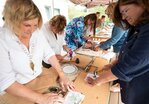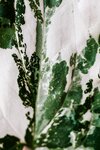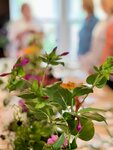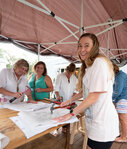






The invitation came via email for last Thursday in Essex. It was a Hammer & Sip event at Anna Hardy’s lovely interior design showroom and shop on Eastern Avenue.
Hammer and sip? Hmm, well, my first thought went to the recent trend of bars that offer ax throwing. (Yes, that’s actually a thing).
I was flat wrong.
Yes, there are hammers and, yes, there was wine to sip and finger foods to enjoy.
But this event at Anna Hardy Interiors and Shop—one in a series of workshops exploring design-focused crafts—introduces attendees to an ancient technique of textile design in leaves and flowers are hammered onto fabric, leaving an imprint from the natural “ink.”
This unique art is not at all new, and it’s simple. Just gather leaves and flowers from the outdoors and assemble your needed tools: a hammer, some masking tape, fabric for printing, a board to hammer on, and a piece of wax paper.
The art of hammered leaf and flower textile art goes way back in history and draws inspiration from cultures around the world. Indigenous traditions, like the Native American use of natural materials in textile art. This hammering technique is largely associated with the Cherokee peoples (some call it “the Cherokee leaf pounding”). To complete their piece, artisans often add embroidery, embellishments, or other details that complement the hammered design.
With Hardy as our guide, everyone seemed to get the idea quickly and, before long, everyone was making designs by laying out leaves and flower petals on fabrics. Choosing suitable plant specimens is paramount, we were told, as they must be both visually appealing and capable of retaining their colors post-hammering.
Hardy, who wore a white cotton blouse that featured her own hammered leaf printing skills, said proper drying and preservation methods (like setting the design with vinegar) would ensure the hammered print would retain its color and vibrancy.
Many of us learned that design layout is a crucial step, requiring careful planning and consideration of color combinations and compositions. Some participants did a better job than others, layering leaves and flowers onto chosen fabric and hammering (gently, we were instructed) to transfer the pigments from the plants onto the fabric, creating intricate imprints that capture the beauty of each botanical element.
In a world filled with wonders of technology, the act of hammering natural materials like leaves and flowers textile harkens back to a simpler time when people seemed more connected to nature. It also just feels good to make something so beautiful with tools and materials that are easy, affordable, and utterly within reach.